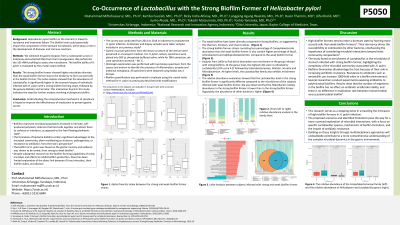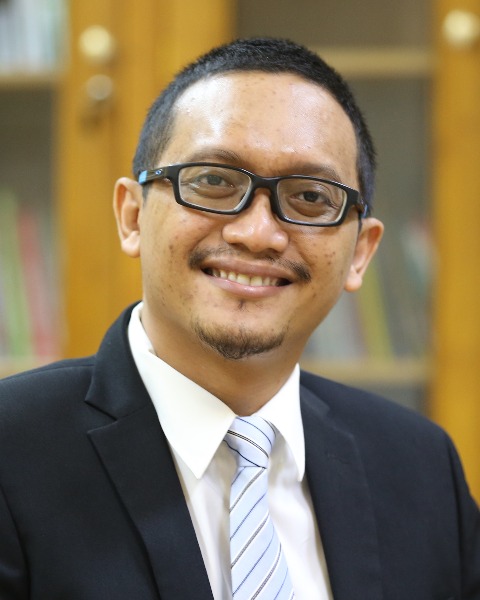Tuesday Poster Session
Category: Stomach
P5050 - Co-Occurrence of Lactobacillus With the Strong Biofilm Former of Helicobacter pylori
Tuesday, October 29, 2024
10:30 AM - 4:00 PM ET
Location: Exhibit Hall E

Has Audio

Muhammad Miftahussurur, MD, PhD
Universitas Airlangga
Surabaya, Jawa Timur, Indonesia
Presenting Author(s)
Muhammad Miftahussurur, MD, PhD1, Kartika Fauziah, MD, PhD2, Ricky Indra Alfaray, MD, PhD3, Langgeng Agung Waskito, MD, PhD1, Husin Thamrin, MD1, Ulfa Kholili, MD1, Junko Akada, MD, PhD3, Takashi Matsumoto, MD, PhD3, Yoshio Yamaoka, MD, PhD3
1Universitas Airlangga, Surabaya, Jawa Timur, Indonesia; 2National Research and Innovation Agency, Jakarta, Jakarta Raya, Indonesia; 3Oita University, Oita, Oita, Japan
Introduction: <em>Helicobacter pylori</em> biofilm in the stomach is linked to resistance and treatment failure. The biofilm level could potentially impact the composition of the stomach microbiome, which plays a role in the development of diseases and immune reactions. However, the traditional phenotypic approach is not sufficient and microbiome profiling can be done using the 16S rRNA sequencing approach.
Methods: We collected 44 gastric biopsies from a nationwide survey in Indonesia and extracted DNA from their homogenates. We performed the 16S rRNA profiling to assess the microbiome. The biofilm ability of <em>H. pylori</em> is evaluated by the crystal violet method.
Results: The research indicates that the strong biofilm former exhibited higher alpha diversity (Shannon, Simpson, and Chao1) compared to the weak biofilm former (P-Value >0.05) due to its tendency to form coccoid cells in the biofilm. Additionally, the biomarker analysis identified Lactobacillus as the highest-scoring genus with a LefSe score of 4.1, followed by <em>Dialister </em>(LefSe score of 3.5) and Serratia (LefSe score of 3.2). The abundance of<em> Lactobacillus</em> was significantly higher in the stomach biopsy of individuals infected with <em>H. pylori</em> with a strong biofilm-forming strain (P Value < 0.044). This finding showed the possible beneficial effect of <em>Lactobacillus</em> due to its ability to persist among high biofilm former strains.
Discussion: High-biofilm formers tend to enter a dormant state by forming more coccoid cells than weak biofilm formers. Thus, their dormancy drives the susceptibility to colonization by other bacteria. Lactobacillus could be the most survivable organism during the H. pylori infection. This finding emphasizing the importance of considering microbial interactions beyond static community compositions. This finding highlights the importance of further research on multispecies biofilm interactions to better improve eradication effectiveness in preventing gastric cancer.
Disclosures:
Muhammad Miftahussurur, MD, PhD1, Kartika Fauziah, MD, PhD2, Ricky Indra Alfaray, MD, PhD3, Langgeng Agung Waskito, MD, PhD1, Husin Thamrin, MD1, Ulfa Kholili, MD1, Junko Akada, MD, PhD3, Takashi Matsumoto, MD, PhD3, Yoshio Yamaoka, MD, PhD3. P5050 - Co-Occurrence of <i>Lactobacillus</i> With the Strong Biofilm Former of <i>Helicobacter pylori</i>, ACG 2024 Annual Scientific Meeting Abstracts. Philadelphia, PA: American College of Gastroenterology.
1Universitas Airlangga, Surabaya, Jawa Timur, Indonesia; 2National Research and Innovation Agency, Jakarta, Jakarta Raya, Indonesia; 3Oita University, Oita, Oita, Japan
Introduction: <em>Helicobacter pylori</em> biofilm in the stomach is linked to resistance and treatment failure. The biofilm level could potentially impact the composition of the stomach microbiome, which plays a role in the development of diseases and immune reactions. However, the traditional phenotypic approach is not sufficient and microbiome profiling can be done using the 16S rRNA sequencing approach.
Methods: We collected 44 gastric biopsies from a nationwide survey in Indonesia and extracted DNA from their homogenates. We performed the 16S rRNA profiling to assess the microbiome. The biofilm ability of <em>H. pylori</em> is evaluated by the crystal violet method.
Results: The research indicates that the strong biofilm former exhibited higher alpha diversity (Shannon, Simpson, and Chao1) compared to the weak biofilm former (P-Value >0.05) due to its tendency to form coccoid cells in the biofilm. Additionally, the biomarker analysis identified Lactobacillus as the highest-scoring genus with a LefSe score of 4.1, followed by <em>Dialister </em>(LefSe score of 3.5) and Serratia (LefSe score of 3.2). The abundance of<em> Lactobacillus</em> was significantly higher in the stomach biopsy of individuals infected with <em>H. pylori</em> with a strong biofilm-forming strain (P Value < 0.044). This finding showed the possible beneficial effect of <em>Lactobacillus</em> due to its ability to persist among high biofilm former strains.
Discussion: High-biofilm formers tend to enter a dormant state by forming more coccoid cells than weak biofilm formers. Thus, their dormancy drives the susceptibility to colonization by other bacteria. Lactobacillus could be the most survivable organism during the H. pylori infection. This finding emphasizing the importance of considering microbial interactions beyond static community compositions. This finding highlights the importance of further research on multispecies biofilm interactions to better improve eradication effectiveness in preventing gastric cancer.
Disclosures:
Muhammad Miftahussurur indicated no relevant financial relationships.
Kartika Fauziah indicated no relevant financial relationships.
Ricky Indra Alfaray indicated no relevant financial relationships.
Langgeng Agung Waskito indicated no relevant financial relationships.
Husin Thamrin indicated no relevant financial relationships.
Ulfa Kholili indicated no relevant financial relationships.
Junko Akada indicated no relevant financial relationships.
Takashi Matsumoto indicated no relevant financial relationships.
Yoshio Yamaoka indicated no relevant financial relationships.
Muhammad Miftahussurur, MD, PhD1, Kartika Fauziah, MD, PhD2, Ricky Indra Alfaray, MD, PhD3, Langgeng Agung Waskito, MD, PhD1, Husin Thamrin, MD1, Ulfa Kholili, MD1, Junko Akada, MD, PhD3, Takashi Matsumoto, MD, PhD3, Yoshio Yamaoka, MD, PhD3. P5050 - Co-Occurrence of <i>Lactobacillus</i> With the Strong Biofilm Former of <i>Helicobacter pylori</i>, ACG 2024 Annual Scientific Meeting Abstracts. Philadelphia, PA: American College of Gastroenterology.
